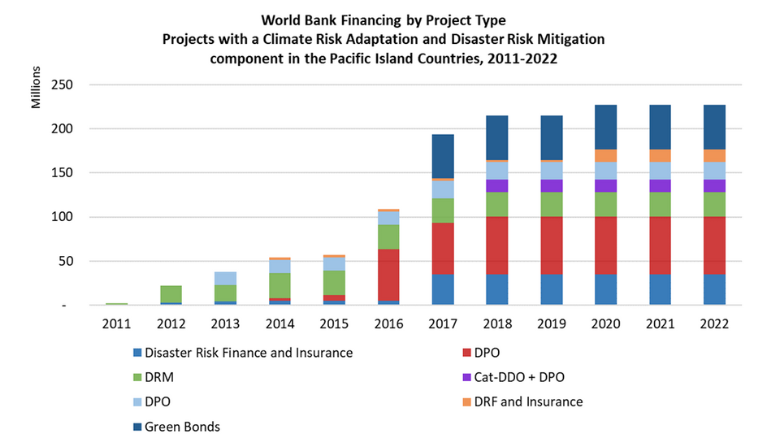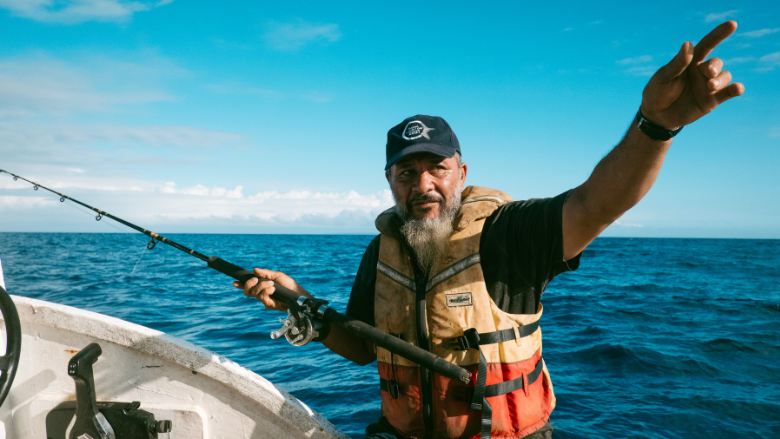KEY HIGHLIGHTS
$2.6 billion in commitments for 90 projects in 12 countries.
50 percent of Kiribati’s population benefited from road improvements.
Collectively, 45 percent of the population across the Federated States of Micronesia, Kiribati, Samoa, Tonga, Tuvalu, and Vanuatu are expected to benefit from greater access to resilient transport services as a result of World Bank support.
- 106 percent increase in net income of Papua New Guinea’s cocoa growers through livelihoods improvement project.
CHALLENGE
The Frontlines of Climate Change
Over the past decade, the Small Island Developing States of the Pacific have recognized the urgent need to address climate change and have made efforts to mitigate its effects and adapt to changing conditions. These nations are responsible for only 0.03 percent of global greenhouse gas emissions, but are among the world’s most vulnerable to natural disasters and continue to experience the worst impacts of climate change. These include the immediate threat of increasingly severe cyclones, and the likely impacts of sea level rise in the near future; this puts the region’s cities at risk, compounded by a rapid urbanization rate that is expected to rise from 76 percent in 2018 to 85 percent by 2050. Annual expected losses from natural disasters represent around 2–3 percent of gross domestic product (GDP) for Pacific Island countries, and are only partially offset by post-disaster donor finance. The economic and health impacts of the COVID-19 pandemic added another layer of complexity to the urgent climate challenge facing Pacific Islands, and underscore the need to ensure a recovery that is green, resilient, and inclusive.
APPROACH
A Comprehensive Response to Unique Challenges
The World Bank has a long record of support for Pacific Islands in climate adaptation and disaster risk management, protecting both lives and livelihoods. The World Bank has rapidly increased its assistance to scale up climate resilience and disaster preparedness and response in the region through the International Development Association (IDA) and International Bank for Development and Reconstruction (IBRD) support, trust funds, and co-financing. World Bank commitments for climate adaptation and disaster risk management in the region were $777 million in 2023. Areas of support cover a range of analytical work, policy reform, and investments in adaptation and resilience. These include disaster and climate risk assessments; innovative risk financing mechanisms; risk reduction measures, including early warning systems and enhancing resilient housing and infrastructure; rapid response and damage assessments following disasters; and climate-related prior actions in Development Policy Operations (DPOs).
RESULTS
Resilience through Financial Protection and Economic Development
The World Bank has helped bring pioneering market-based solutions in risk financing to the Pacific Islands. These include a range of instruments, knowledge products, and tools, ranging from green bonds, to lending operations, to regional risk-pooling. One such instrument is the Catastrophe Deferred Drawdown Option (Cat-DDO), which mobilizes immediate funds in the event of a disaster and has been integral to climate risk management projects in the region since 2018. Cat-DDOs totaling $274 million were provided to Fiji, Samoa, Tonga, Tuvalu, and Vanuatu between 2018 and 2022; a further $201 million is currently in the pipeline for these and an additional three countries. The World Bank provided initial support for the development of a regional cooperative insurance mechanism in the Pacific islands to help mitigate the financial cost of climate shocks in 2015, which is now an independent entity. The Pacific Catastrophe Risk Assessment and Financing Initiative (PCRAFI), a multi-donor trust fund, is now providing technical assistance for disaster risk assessments in 15 Pacific countries with tools to help them better understand, model, and assess their exposure to disasters.
In 2017, with World Bank and International Finance Corporation (IFC) support, Fiji became the first emerging market to issue a sovereign green bond, raising $50 million. The proceeds of the bond supported investments to build resilience to the impacts of climate change and help Fiji achieve its commitment to 100 percent renewable energy and reduce its carbon dioxide emissions in the energy sector 30 percent by 2030.
Immediate Response to a Devastating EruptionIn January 2022 the Kingdom of Tonga experienced a massive natural disaster with the eruption of the Hunga Tonga-Hunga Ha’apai undersea volcano and subsequent tsunami, which caused over $90 million in damages—around 18 percent of GDP—and impacted 85 percent of the country’s population. Within 24 hours of receiving the government’s request for assistance, the World Bank delivered $8 million in funding through a Cat-DDO to support Tonga’s immediate response needs. The support was part of a hybrid operation that was put in place to strengthen Tonga’s resilience shortly before the volcanic eruption. The World Bank, through IDA, provided $19 million, comprising a $11 million Development Policy Operation and the $8 million Cat-DDO. This hybrid approach was specifically designed for small countries that are highly exposed to natural hazards, with immediate budget support addressed through the DPO while the Cat-DDO provides financing to support resilience to climate change immediately after a catastrophic event. Combining these multiple functions reduced duplication in preparation efforts, while ensuring that resilience work was a central part of project design. Following the disaster the World Bank provided support for three operations: (i) supplemental financing for the DPO/Cat-DDO; (ii) additional financing for the Tonga Safe and Resilient Schools Project (TSRSP, $10 million); and (iii) additional financing for the Pacific Resilience Program (PREP, $5 million). Under TSRSP, the additional financing will support the repair and reconstruction of the 10 schools severely impacted by the tsunami, and a broader scale-up of resilient school investments to benefit an estimated 6,000 school children. The additional PREP financing supported the Tonga Component of the PREP, which takes a regional approach to strengthening emergency early warning systems and improving disaster preparedness. Since launching in Tonga in 2015, PREP has provided disaster response training for government staff and supported the construction of two Emergency Operations Centers, which were critical in the immediate response to the tsunami. |
Economic development is a key pillar of resilience; agriculture, fisheries, and service sectors like tourism form the economic backbone of many Pacific Island countries. In 2020, these sectors represented 74 percent of the GDP of the Pacific small states. Over the last decade, Pacific Island countries have more than doubled their total fisheries production in metric tons (116 percent increase between 2010-2021); the World Bank is supporting Pacific Island countries in strengthening the monitoring, control, and surveillance of illegal, unreported, and unregulated fishing to help ensure the industry is transparent and sustainable. The Pacific Islands Regional Oceanscape Program (PROP) is working in seven Pacific Island countries to support improved and sustainable fisheries management, and to diversify incomes to include training in areas like pearl cultivation and giant clam farming.
“I’m very grateful and thankful that I’m involved in pearl farming, which is another option for me. Our tourism business is locked down. But with the pearls, we do exports. Even without tourists coming, we are still able to export our products,” said Fai’ana Fukofuka, a pearl farmer and tourism operator in ‘Ofu Island in Tonga.
In Papua New Guinea, the Productive Partnerships in Agriculture Project (PPAP) has promoted rural development and poverty reduction, increasing the net income of the project’s targeted cocoa growers by 106 percent and of its coffee producers by 92 percent since 2012. The Samoa Agriculture Competitiveness Enhancement Project (SACEP) has seen a 53 percent increase in vegetable yield among semi-commercial growers and 36 percent among subsistence farmers (2015), helping transform a sector in which two out of three Samoans are employed, and improving food security for the population.
In small island states, infrastructure sectors like transport often represent a large share of public assets; a third of the total government budget in Fiji is spent on the transport sector. Efficient transport systems connect people to economic opportunities and enable access to essential services like healthcare and education. They are particularly critical where major economic activity is dependent on sectors like agriculture and tourism. In countries highly vulnerable to the impact of extreme weather, building the resilience of transport networks is essential. The Pacific Aviation Investment Program has delivered major reconstruction works to airports and runways in Kiribati, Samoa, the Solomon Islands, Tonga, Tuvalu, and Vanuatu, helping to make air travel safer and more efficient across the Pacific. In Kiribati, two airports were upgraded to align with international safety and security standards, key reforms were passed to separate the operational and regulatory function within the sector, and the annual number of passengers at both airports rose more than 30 percent between 2017 and 2018. The Pacific Climate Resilient Transport Program is building resilience in key roads, ports and other transport infrastructure in the Federated States of Micronesia, Kiribati, the Marshall Islands, Samoa, the Solomon Islands, Tonga, Tuvalu, and Vanuatu; upgrading the climate resilience of nearly 150 kilometers of roads, eight maritime sites (such as ports, wharves, or jetties), and one airport. The road improvements being delivered through this program are expected to benefit approximately 84 percent of Tongans across the kingdom’s four most populated islands.
DATA HIGHLIGHTS

PARTNERSHIPS
Collaborating to Build Advocacy and Resilience
The World Bank brings Pacific Island countries together with other small countries in the Small States Forum (SSF), an important platform for high-level dialogue and advocacy on the special development needs of these states. Around two thirds of SSF countries are island states, many of them in the EAP region. The World Bank also works with governments, development institutions, CSOs, and the private sector on some of the more challenging issues facing the region. One of these is school infrastructure, which is disproportionately affected in the event of a disaster. The Pacific Safer Schools Program worked in partnership with the ministries of education in Samoa, Tonga, and Vanuatu to improve the safety and resilience of schools. The program has partnered with the local construction industry in Samoa, Tonga, and Vanuatu to provide assessments of over 6,000 school buildings and 105 health facilities across the three countries; ongoing advisory services and investment projects could make schools safer.
ONE WORLD BANK IN ACTION
At the Summit for a New Global Financial Pact in Paris, in June 2023, World Bank President Ajay Banga announced an expanded toolkit for crisis preparedness, response, and recovery that includes: (i) pausing debt repayments; (ii) redirecting financing; (iii) linking crisis preparedness and financing; (iv); backstopping development projects with private sector support; and (v) building enhanced catastrophe insurance without debt. The toolkit draws on the resources and expertise of all World Bank institutions, including IFC and the Multilateral Investment Guarantee Agency (MIGA), and will be of particular benefit to Pacific Island nations as they contend with the deepening impacts of climate change and disasters.
LOOKING AHEAD
Strengthening the Blue Economy and Deepening Resilience
The compounding impacts of the COVID-19 pandemic and ongoing climate and disaster shocks on Pacific Island countries will continue to pose major challenges for the region in the years ahead. The World Bank’s draft Roadmap for evolving its mission, operations, and resources approaches includes a focus on new global challenges, including climate change—a key priority for the Bridgetown Initiative, with which the World Bank is aligned, and which many of its partners have endorsed. The World Bank is also supporting the 2050 Strategy for the Blue Pacific Continent, the Pacific region’s development blueprint for the decades ahead. The strategy takes a regional approach and prioritizes climate adaptation and resilience. The World Bank’s Climate Change Action Plan 2021-2025 commits the World Bank to helping countries and the private sector to protect marine areas, diversify the blue economy (that is, sustainable use of ocean resources to promote economic growth and improved livelihoods in healthy oceans), reduce marine pollution, and repopulate coral reefs. The World Bank will contribute to blue growth through analytical services, policy dialogue, financing, and supporting activities related to more efficient use of resources—each of which is critical to the resilience of small island developing states in the EAP region.
Last Updated: Dec 06, 2023
